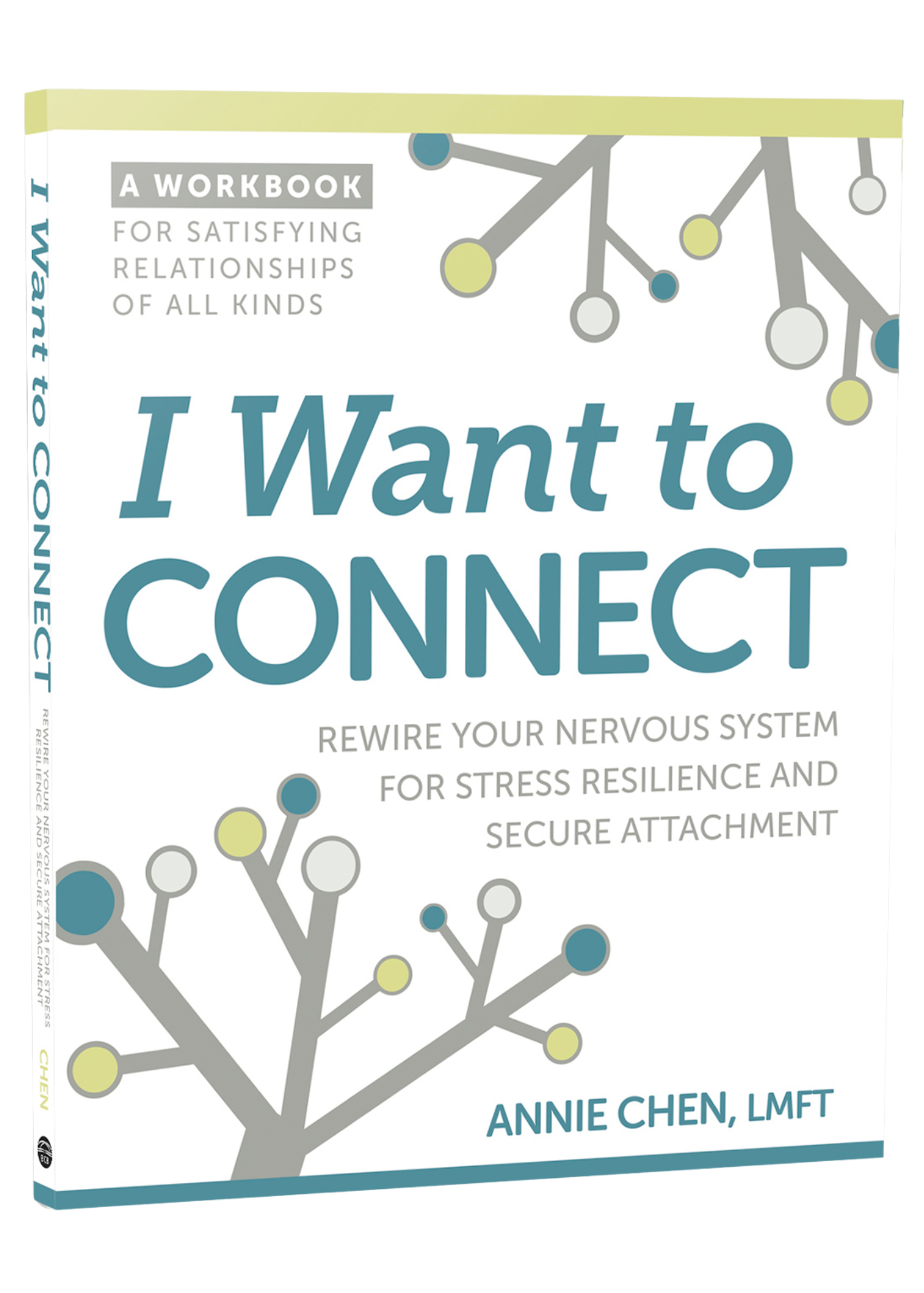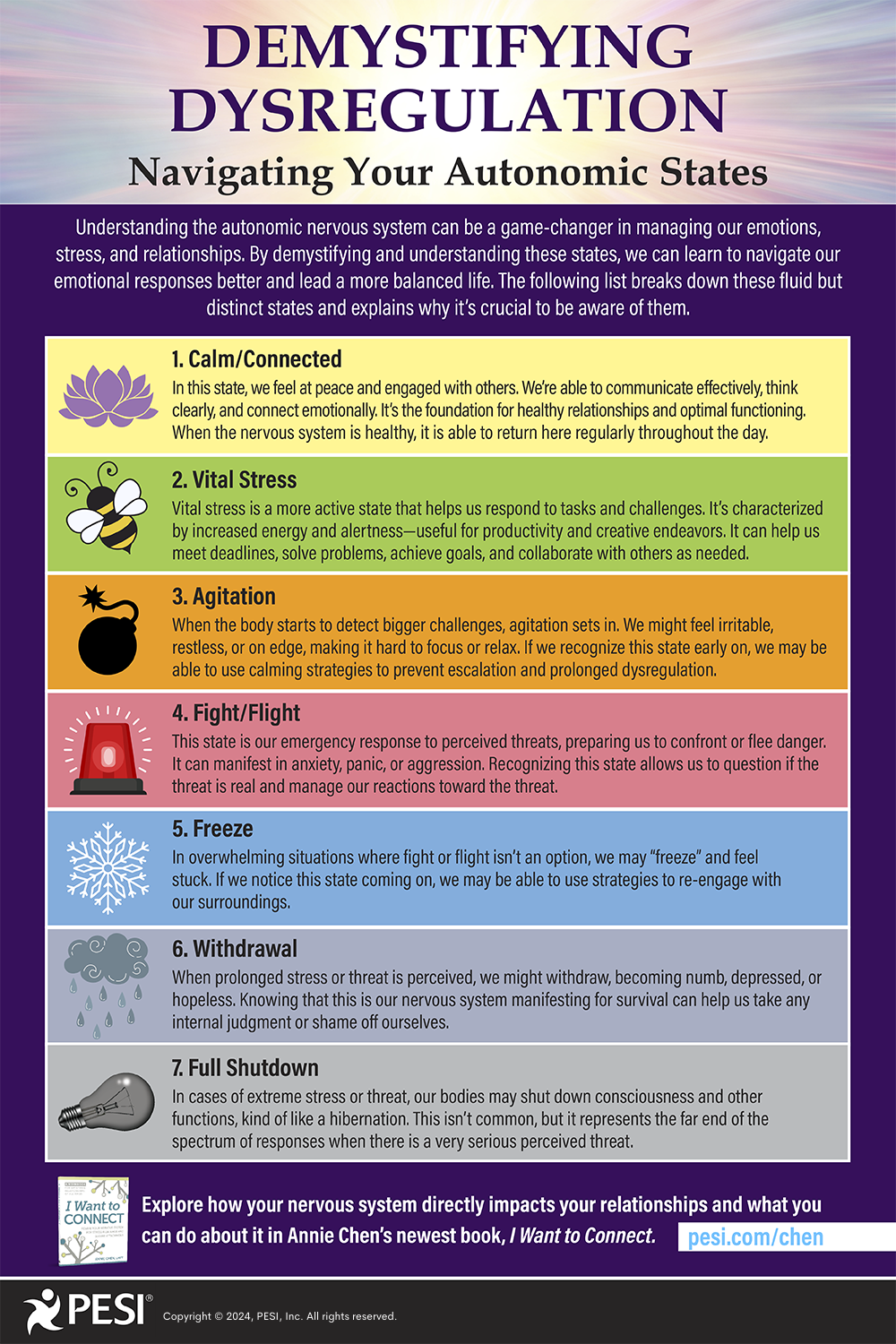Demystifying Dysregulation: Navigating Your Autonomic States

Understanding the autonomic nervous system—the system that controls our automatic body functions—can be a game-changer in managing our emotions, stress, and relationships. This system operates on a spectrum of states, on which we can experience everything from feeling calm and connected to experiencing full shutdown. By demystifying and understanding these states, we can learn to navigate our emotional responses better and lead a more balanced life. The following list breaks down these fluid but distinct states and explains why it’s crucial to be aware of them.
Recognizing these states is a vital skill for managing our lives. Here’s what this skill can do for you:
My new workbook, I Want to Connect: Rewire Your Nervous System for Stress Resilience and Secure Attachment, will teach you not only how to tune into these autonomic states, but also how to reset your body to calm, better communicate with others, and even rediscover yourself.
1. Calm/Connected
In this state, we feel at peace and engaged with others. We’re able to communicate effectively, think clearly, and connect emotionally. It’s the foundation for healthy relationships and optimal functioning. When the nervous system is healthy, it is able to return here regularly throughout the day.2. Vital Stress
Vital stress is a more active state that helps us respond to tasks and challenges. It’s characterized by increased energy and alertness—useful for productivity and creative endeavors. It can help us meet deadlines, solve problems, achieve goals, and collaborate with others as needed.3. Agitation
When the body starts to detect bigger challenges, agitation sets in. We might feel irritable, restless, or on edge, making it hard to focus or relax. If we recognize this state early on, we may be able to use calming strategies to prevent escalation and prolonged dysregulation.4. Fight/Flight
This state is our emergency response to perceived threats, preparing us to confront or flee danger. It can manifest in anxiety, panic, or aggression. Recognizing this state allows us to question if the threat is real and manage our reactions toward the threat.5. Freeze
In overwhelming situations where fight or flight isn’t an option, we may “freeze” and feel stuck. If we notice this state coming on, we may be able to use strategies to re-engage with our surroundings.6. Withdrawal
When prolonged stress or threat is perceived, we might withdraw, becoming numb, depressed, or hopeless. Knowing that this is our nervous system manifesting for survival can help us take any internal judgment or shame off ourselves.7. Full Shutdown
In cases of extreme stress or threat, our bodies may shut down consciousness and other functions, kind of like a hibernation. This isn’t common, but it represents the far end of the spectrum of responses when there is a very serious perceived threat.Recognizing these states is a vital skill for managing our lives. Here’s what this skill can do for you:
- Enhance emotional intelligence: Understanding our autonomic states helps us identify our emotions and respond to them constructively.
- Improve relationships: By knowing our states, we can communicate our needs more clearly and understand others better, leading to healthier interactions.
- Manage stress: Awareness allows us to implement strategies to return to a calm state, reducing the impact of stress on our health.
My new workbook, I Want to Connect: Rewire Your Nervous System for Stress Resilience and Secure Attachment, will teach you not only how to tune into these autonomic states, but also how to reset your body to calm, better communicate with others, and even rediscover yourself.
Rewire Your Nervous System for Stress Resilience and Secure Attachment

In I Want to Connect, a follow-up to the popular The Attachment Theory Workbook, expert relationship therapist Annie Chen explores how your nervous system directly impacts your relationships and what you can do about it. Weaving together insights from Polyvagal Theory, somatic practices, and relationship co-regulation skills, this workbook addresses a range of issues through a central connecting point: that the state of our nervous system either primes us for resilience and connection or pushes us toward defense and shutdown.
Online Course:
Integrating Attachment Science to Maximize Treatment with IFS, EFIT, Polyvagal Theory, EMDR and More
Integrating Attachment Science to Maximize Treatment with IFS, EFIT, Polyvagal Theory, EMDR and More

Revolutionize your practice through the power of attachment! This online training brings together leading experts in attachment science, including Dan Siegel, Dan Hughes, Claire Mellenthin and many others. Discover today's most popular, evidence-based approaches in psychotherapy - Emotionally Focused Individual Therapy (EFIT), Internal Family Systems (IFS), Expressive Therapies, and more – so you can help clients of all ages loosen the grip of attachment ruptures, restore sense of self, and develop the ability to connect and repair.
Meet the Expert:
Annie Chen, LMFT, currently runs a private practice in Berkeley, CA, where she counsels individuals and couples on all relationship matters. She helps train fellow therapists in PACT, a couples therapy modality grounded in attachment and somatics, and collaborates on a research team studying the model’s effectiveness. Annie holds dual master’s degrees in counseling and psychology, where her passion for the clinical applications of neuroscience is reflected in two thesis projects. She is the author of The Attachment Theory Workbook, published in 2019.
Learn more about her educational products, including upcoming live seminars, by clicking here.
Learn more about her educational products, including upcoming live seminars, by clicking here.






